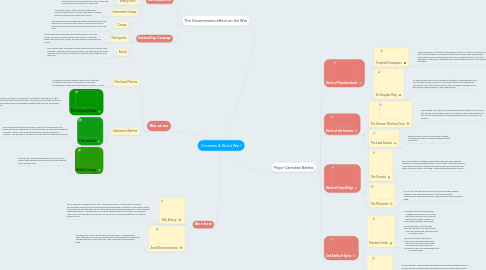
1. The Governments affect on the War
1.1. War measures act
1.1.1. Economic Control
1.1.1.1. The War Measures act gave the government of Canada pretty well total power over the imports and exports in the country. The purpose was to focus all of Canada's Economic strength towards the war effort.
1.1.2. "Enemy Alien"
1.1.2.1. People suspected of being a threat or at war towards the government was considered an "enemy alien" and could imprisoned, deported, or even both.
1.1.3. Internment Camps
1.1.3.1. Among the "Enemy Aliens" was More than 8500 recent immigrants from Germany and Austro-Hungary that were imprisoned in Internment camps.
1.2. Hundred Days Campaign
1.2.1. Causes
1.2.1.1. The Hundred Days campaign was caused by the advance of the Germans in to France and the arrival of the American troops. When the Americans arrived, the front line was only 75 km from Paris.
1.2.2. Participants
1.2.2.1. The Hundred days Campaign was an attack plan of the allied forces. The allied forces at that time consisted of The British Empire and its colonies, France, and the recently joined American troops.
1.2.3. Result
1.2.3.1. The Hundred Days Campaign ultimately was the end of the war. after Germany's extensive advances into France, The allied forces drove the Germans back to Bavaria resulting in a cease fire that ended the first world war.
2. War at sea
2.1. Merchant Marines
2.1.1. Merchants and sailors played a pivotal part in the war by supplying the allies on the western front, even though many of them were shot down by German U-boats.
2.2. Submarine Warfare
2.2.1. The German U-Boat
2.2.1.1. Germany used the U-boats which are essentially submarines, to fight against the much larger British navy. They were mainly missioned to halt the merchant sailers and freighters supplying the allies on the western front.
2.2.2. The Lusitania
2.2.2.1. The Lusitania was a British ocean liner, holder of the Blue Riband, and briefly the world's biggest ship. It was shot down off the coast of Britain by a German U-boat, while filled with American nationals enroute to Liverpool. This was one of the causes of America joining the first world war.
2.2.3. British Convoys
2.2.3.1. Durin the war, Britain relied heavily on its own navy to protect the freighters that brought troops and supplies to the Western Front.
3. War in the air
3.1. Billy Bishop
3.1.1. Billy Bishop was Canada's top "air ace" in the first world war. He shot down 72 planes, becoming the second most successful pilot behind Germany's "Red Baron". Billy wrote a letter to his wife that described the realism of the war from the soldiers perspective: "I am thoroughly downcast tonight.... Sometimes all of this awful fighting makes you wonder if you have the right to call your self human. My honey, I am so sick of it all, the killing, the war. All i want is home and you."
3.2. Aerial Reconnaisance
3.2.1. Airplanes were a very new invention during the war. In the beginning years, they were only used for reconnaissance (observation) of the enemy and the battlefield. Not till the later years of the war did aerial battle begin.
4. Major Canadian Battles
4.1. Battle of Passchendaele
4.1.1. Torrential Downpoor
4.1.1.1. Within a few days of the battle, the heaviest rainfall in 30 years occurred turning the soil into quagmire. The quagmire made the mud very thick and this mud broke many rifles by clogging them and it also immobilized tanks. At a future date the mud became so deep that men and horses drowned in it. This stopped the battle.
4.1.2. Sir Douglas Haig
4.1.2.1. Sir Doulgas Haig was the Commander of the Battle of Passchendaele and also the Battle of the Somme.He commanded the British Expeditionary Force (BEF) from 1915 to the end of the war. Sir Douglas Haig was one of the most successful leaders of the Triple Entente.
4.2. Battle of the Somme
4.2.1. The German Machine Guns
4.2.1.1. Even though The Allied forces technically won the Battle of the Somme, the German Machine guns killed of the nearly a million. The heaviest loss was for the Newfoundland royal Regiment which lost 90 percent of its soldiers.
4.2.2. The Lead Assults
4.2.2.1. Despite Heavy losses on the first day of battle, including nearly 58,000 British troops,the attack continued.
4.3. Battle of Vimy Ridge
4.3.1. The Tunnels
4.3.1.1. The very successful Canadian soldiers were assigned with capturing Germany's most invulnerable position, Vimmy Ridge. Lieutenant-General Julian Byng's plan was to tunnel past layers of the German defence and attack from the inside of the Ridge. This plan was extremely successful.
4.3.2. The Memorial
4.3.2.1. On July 26 1936 the French Government unveiled the Canadian National Vimy Memorial in honour of "the valour of their countrymen in the Great War and in memory of their sixty thousand dead
4.4. 2nd Battle of Ypres
4.4.1. Flanders Fields
4.4.1.1. In Flanders fields the poppies blow Between the crosses, row on row, That mark our place; and in the sky The larks, still bravely singing, fly Scarce heard amid the guns below. We are the Dead. Short days ago We lived, felt dawn, saw sunset glow, Loved and were loved, and now we lie In Flanders fields. Take up our quarrel with the foe: To you from failing hands we throw The torch; be yours to hold it high. If ye break faith with us who die We shall not sleep, though poppies grow In Flanders fields.
4.4.2. Chlorine Gas
4.4.2.1. The 2nd Battle of Ypres was the first battle to include the widespread use of chlorine gas. the Germans with gas masks were safe unlike the allied forces. The only solution found by the soldiers at the time was covering their face with urine soaked handkerchiefs. This was complete horror that took many lives.
